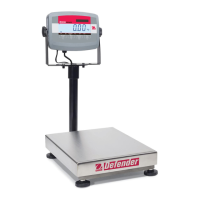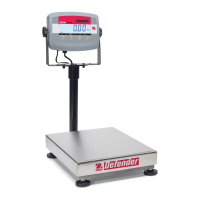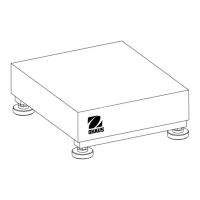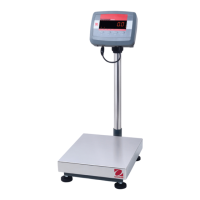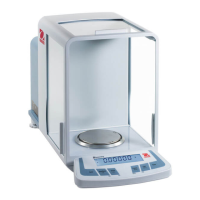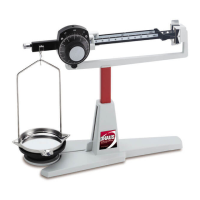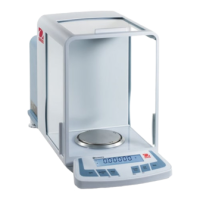Do you have a question about the OHAUS Defender 5000 and is the answer not in the manual?
General safety guidelines for operating the equipment.
Specific safety warnings for the optional Relay I/O board.
List of items included in the product package.
Steps for connecting the scale base and power supply.
Procedures for opening the housing and making internal connections.
Instructions for reorienting the TD52XW rear housing.
Details on how to attach the mounting bracket.
Overview of the indicator's menu hierarchy and options.
Steps for navigating through menus and changing settings.
Details on calibration procedures: Zero, Span, and Linearity.
Configuration options for capacity, range, language, and power settings.
Options for customizing display features like stability and filter.
Configuration of discrete inputs and outputs for application modes.
Selection and configuration of different weighing units.
Settings for Good Laboratory Practice and Good Manufacturing Practice data.
Configuration of serial, Ethernet, Wi-Fi, and Bluetooth communication.
Settings related to the service menu for maintenance.
Options for locking specific keys on the keypad.
Using the application to determine the weight of items.
Instructions for using the application to count samples.
Procedure for comparing weight or pieces against target limits.
Using Percent Weighing to measure sample weight against a reference.
Application for weighing unstable loads or moving animals.
List and description of OHAUS and MT-SICS interface commands.
Details on RS232 (DB9) pin connections.
Steps to connect the indicator to a computer via serial cable.
Steps to connect the indicator to a serial printer.
Format and content of printouts for weighing and check applications.
Illustrative examples of printout configurations.
Information on managing libraries and records on the SD card.
Managing user profiles, roles, and login procedures.
Using the Alibi memory for record keeping and data retrieval.
Configuring the link to save data in editable formats.
Steps for configuration, verification, and sealing for legal trade.
Procedure for verification by authorized personnel.
Methods for applying security seals to prevent tampering.
Instructions for cleaning the T52P indicator housing and control panel.
Instructions for cleaning the TD52XW indicator housing and control panel.
Table of common symptoms, probable causes, and remedies.
Contact information for technical support and service.
Detailed technical specifications of the indicator models.
List of available accessories and optional kits.
Dimensional drawings and measurements of the indicator units.
Table of GEO codes for location-based calibration adjustments.
Details on standard continuous output formats and status byte definitions.
Reference for MT-SICS commands used by the indicator.
General safety guidelines for operating the equipment.
Specific safety warnings for the optional Relay I/O board.
List of items included in the product package.
Steps for connecting the scale base and power supply.
Procedures for opening the housing and making internal connections.
Instructions for reorienting the TD52XW rear housing.
Details on how to attach the mounting bracket.
Overview of the indicator's menu hierarchy and options.
Steps for navigating through menus and changing settings.
Details on calibration procedures: Zero, Span, and Linearity.
Configuration options for capacity, range, language, and power settings.
Options for customizing display features like stability and filter.
Configuration of discrete inputs and outputs for application modes.
Selection and configuration of different weighing units.
Settings for Good Laboratory Practice and Good Manufacturing Practice data.
Configuration of serial, Ethernet, Wi-Fi, and Bluetooth communication.
Settings related to the service menu for maintenance.
Options for locking specific keys on the keypad.
Using the application to determine the weight of items.
Instructions for using the application to count samples.
Procedure for comparing weight or pieces against target limits.
Using Percent Weighing to measure sample weight against a reference.
Application for weighing unstable loads or moving animals.
List and description of OHAUS and MT-SICS interface commands.
Details on RS232 (DB9) pin connections.
Steps to connect the indicator to a computer via serial cable.
Steps to connect the indicator to a serial printer.
Format and content of printouts for weighing and check applications.
Illustrative examples of printout configurations.
Information on managing libraries and records on the SD card.
Managing user profiles, roles, and login procedures.
Using the Alibi memory for record keeping and data retrieval.
Configuring the link to save data in editable formats.
Steps for configuration, verification, and sealing for legal trade.
Procedure for verification by authorized personnel.
Methods for applying security seals to prevent tampering.
Instructions for cleaning the T52P indicator housing and control panel.
Instructions for cleaning the TD52XW indicator housing and control panel.
Table of common symptoms, probable causes, and remedies.
Contact information for technical support and service.
Detailed technical specifications of the indicator models.
List of available accessories and optional kits.
Dimensional drawings and measurements of the indicator units.
Table of GEO codes for location-based calibration adjustments.
Details on standard continuous output formats and status byte definitions.
Reference for MT-SICS commands used by the indicator.
| Readability | 0.1 g |
|---|---|
| Display | LCD with backlight |
| Calibration | External calibration |
| Stabilization Time | 2 seconds |
| Auto-Off | Adjustable |
| Power | AC adapter or rechargeable battery |
| Construction | Stainless steel platform |
| Operating Temperature | -10°C to 40°C |
| Approval | NTEP approved |
| Operating Modes | Weighing, Checkweighing, Display Hold |
| Communication | RS-232 |
| Units of Measurement | Grams, Kilograms, Pounds, Ounces |
